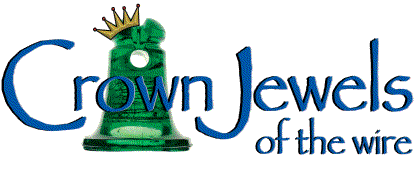CD 742.5 Battleford Baby
by J. H. Hayes
Reprinted from "INSULATORS - Crown Jewels of the Wire", February 1977, page 15
At the Toronto Yorktown 7 Show & Sale on November 14, 1976, a little more
information was added to our knowledge of the origin and existence of
insulators.
Norm Banks and his brother Gord of Burford, Ontario, brought in a wood
covered black glass insulator like the new Wade I reported in the April
Insulators magazine. The most interesting feature about this insulator, although
most of the wood had rotted away, was the iron band around it. This band is
exactly the same as the one shown on page 265 of History, Theory and Practice
of the Electric Telegraph by George B. Prescott, 1866, Boston (See
reproduction.). Further reference was made in March 1973 Cross Arms magazine,
page 22. This reference indicates that the insulator was made by Charles T.
and J. N. Chester of New York. It is interesting that one of these should be
found in Canada. It may have been made under license, or, as in the case of many
others, imported. Nevertheless, it would appear that what I thought in April to
be a Canadian insulator is more likely a Chester. One factor to consider,
however, is that when you hold this Wade-type insert beside a Baby Battleford,
from the bottom view you can't tell which is which.

This leads me to the next interesting item to appear at the show--an aqua
Baby Battleford that was found recently at the site of the Hamilton Glass Works
in Ontario, by a contractor. It has been speculated that the Battleford was made
in Hamilton, as the contractor that built the Battleford line in the 1800's was
from that city. It was also reported that the Battleford might have been made by
Foster Bros. of St. John, Quebec (September 1973 Old Bottle Magazine). Shards of
two other insulators were found at the same time--a 726 aqua and a dark green
threadless I could not identify. The 726 was also made at the Canada Glass Works
at Hudson, Quebec, as pieces were found there, as well, with the flat base. It
is possible the Hamilton company made the one with the M T Co type base. The
piece of 726 found at Hamilton did not have the base section, so this factor
could not be determined.
The only other insulator that turned up during a most exciting day was one
half of a 737.5 that a man from Hamilton brought in. He had found this aqua
insulator (same size as shown on page 333 of Milholland's 3rd Revision) in
Hamilton, but not at the Glass Company site.
Unfortunately, I am still missing a good deal of information on the above
items, and my camera failed on trying to take a picture of the iron ringed item.
I will try again if I get the opportunity.

I am enclosing two pictures of downtown Ottawa from the National Archives collection. The one at the left, "Sparks St. 1866", shows a pole
with a dozen insulators, 742's and 718's, I believe. The other, 1874 on the
same street, shows 742's on the pole in the foreground. I have enlarged copies
of these pictures and a couple others made. As I look upon these gems along the
street on which the office I work in is located, I wonder where they were
thrown. I shall continue to keep looking.

|
